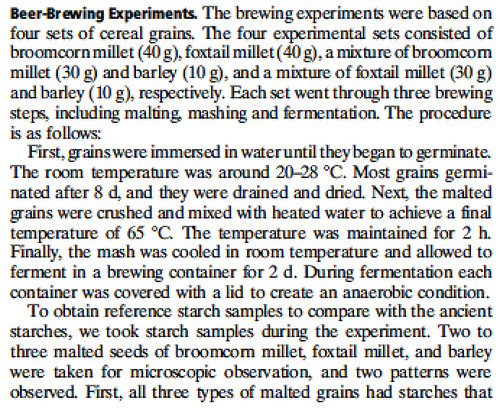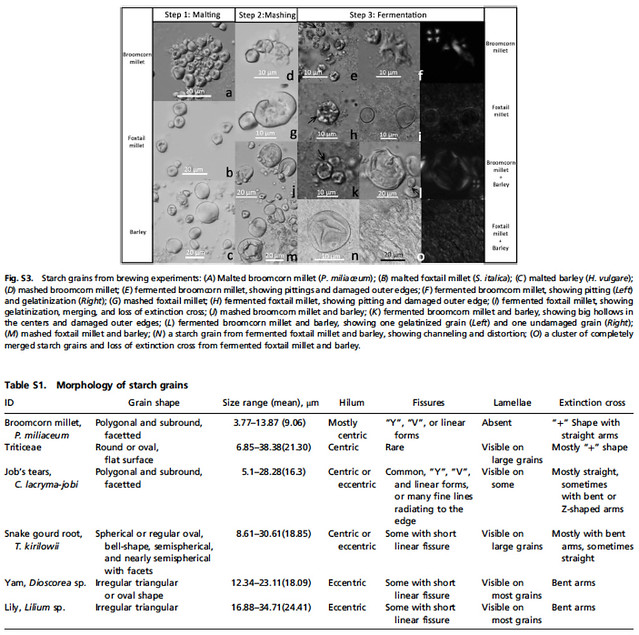![]()
There was exciting news yesterday about a find in China by a research team from Stanford University. According to one source, “Archaeologists have discovered what they believe to be the earliest direct evidence of beer brewing in China, a trove of beer-making equipment dating from between 3400 and 2900 BCE, discovered at the Mijiaya site in Shaanxi province. Along with this archaeological find, scientists conducted an analysis of residue on the ancient pottery, jars, and funnels found, revealing a surprising recipe for the beer.” Their findings will be published in the PNAS (Proceedings of the National Academy of Sciences of the United States of America).
Here’s the abstract:
The pottery vessels from the Mijiaya site reveal, to our knowledge, the first direct evidence of in situ beer making in China, based on the analyses of starch, phytolith, and chemical residues. Our data reveal a surprising beer recipe in which broomcorn millet (Panicum miliaceum), barley (Hordeum vulgare), Job’s tears (Coix lacryma-jobi), and tubers were fermented together. The results indicate that people in China established advanced beer-brewing technology by using specialized tools and creating favorable fermentation conditions around 5,000 y ago. Our findings imply that early beer making may have motivated the initial translocation of barley from the Western Eurasia into the Central Plain of China before the crop became a part of agricultural subsistence in the region 3,000 y later.

Significance
This research reveals a 5,000-y-old beer recipe in which broomcorn millet, barley, Job’s tears, and tubers were fermented together. To our knowledge, our data provide the earliest direct evidence of in situ beer production in China, showing that an advanced beer-brewing technique was established around 5,000 y ago. For the first time, to our knowledge, we are able to identify the presence of barley in archaeological materials from China by applying a recently developed method based on phytolith morphometrics, predating macrobotanical remains of barley by 1,000 y. Our method successfully distinguishes the phytoliths of barley from those of its relative species in China.
I’m not sure how that squares with Chateau Jiahu, the beer made by Dogfish Head based on a 9,000-year-old find in China, from Northern China. They also found preserved pottery jars “in the Neolithic village of Jiahu, in Henan province.” The difference, as far as I can tell is the ingredients themselves, although in both they do use barley. This beer recipe calls for broomcorn millet (Panicum miliaceum), barley (Hordeum vulgare), Job’s tears (Coix lacryma-jobi), and tubers to be fermented, whereas the earlier one from Jiahu used “pre-gelatinized rice flakes, Wildflower honey, Muscat grapes, barley malt, hawthorn fruit, and Chrysanthemum flowers.” So their claim that this is older seems suspect unless there’s some qualifier I’m missing. As is typical, academic papers are only available online if you’re already an academic or are willing to pay to look at it for a short period of time, so I’ve not been able to look at their full claims or at the recipe itself, except what’s been written about it by more mainstream news outlets.
According to Gizmodo’s coverage:
Step aside with your claims to long legacies, craft breweries! This reconstructed beer recipe is over 5,000 years old. It’s the earliest beer recipe—and the earliest known use of barley—in China.
Archaeologists at Stanford University, while digging along China’s Wei River, made an intriguing discovery: A marvelously complete set of brewing equipment. And at the bottom of that equipment was something even more wonderful: Residue from the drink it once brewed.
After scrapping that gunk from the pots, researchers analyzed it and confirmed that it was, indeed, leftover froth from a 5,000-year-old beer. They were also able to pin down the recipe of that beer to an unlikely, but delicious-sounding, combination of broomcorn millet, barley, Job’s tears, and tubers.
So they claim, or rather Stanford claims, this is “the earliest known use of barley in China.” I didn’t think that the Chateau Jiahu added the barley to the original recipe, which was developed with the Patrick McGovern from the University of Pennsylvania, and I have a call into Dogfish Head to find out. But failing that, there’s a 4,000-year difference in the two claims that it seems hard for me to believe the Sanford team wouldn’t have uncovered.
The report from CBS News calls the barley a “secret ingredient,” which seems really odd, but seems to reflect the surprise of the researchers on this project. But McGovern’s find in the Jiahu area of China is more than ten years old, and got considerable media attention when the modern version of the beer was first released in 2007, so again I’m not sure a) how they could have missed it or b) what makes this find different, and if it is why none of the news reports are addressing that difference. Some news outlets, such as IFL Science, do mention that beer is older than 5,000 years, which is fairly well-known. Whether it was known in China at the very beginning, as it was in the fertile crescent seems to be gaining ground as a theory.
Although most of the paper is unavailable, there is supplemental information that is available, and that does give some information about the brewing process:





Just when you think there is something that the Chinese did not invent first, another thing pops up. Spaghetti, Fireworks and now beer. Kinda reminds me of the south park episode “The SImpson’s Did It”.. Cheers! #beerup
It appears to me that the 9000 year old Chinese find is the earliest known alcoholic beverage. It did not have barley in it; Dogfish Head did put barley in their’s. So this recent find is notable, because it does have barley in it. It’s beer.